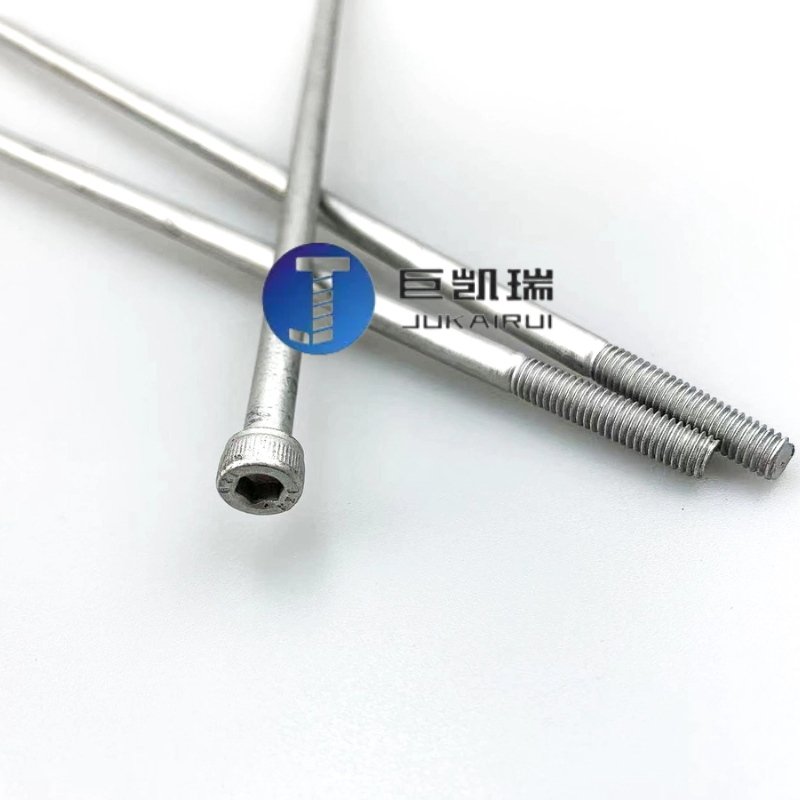Release time:2020-01-16 18:44 Browse:

In mechanical manufacturing and construction engineering, lengthening screws, as the key fasteners, bear the heavy responsibility of connection and fixing. However, in different working environments, such as moisture, salt spray, corrosive gas and other harsh conditions, screws are susceptible to corrosion, thus affecting their performance and safety. In order to extend the service life of the extension screw and ensure the reliability of the connection, various anti-corrosion treatment methods came into being. This article will discuss in detail several main anti-corrosion treatment methods of lengthening screws, including galvanizing treatment, nickel plating treatment, dacromet treatment, blackening treatment, sandblasting treatment and dehydrogenation treatment.
### Galvanized treatment
Galvanizing is one of the most common anti-corrosion treatments for extension screws. By plating a layer of zinc on the surface of the screw, the activity of zinc is given priority to react with oxygen in the environment to form a dense zinc oxide protective film, which effectively prevents further oxidation of the internal metal and achieves the purpose of rust prevention. Galvanizing treatment is divided into hot dip galvanizing and electric galvanizing two kinds:
- ** Hot dip galvanizing ** : Steel parts immersed in molten liquid zinc, through physical and chemical reaction on the surface to form a thick galvanized layer, strong corrosion resistance, suitable for outdoor environment and heavy structural parts. However, the hot-dip galvanizing process is not suitable for high-strength fasteners, because its high temperature can easily lead to the tempering and softening of the material.
- ** Galvanizing ** : Using the principle of electrolysis, a uniform and dense galvanizing layer is formed on the screw surface. The electrogalvanizing process is simple, the cost is low, but the coating is thin, the corrosion resistance is relatively weak, and it is suitable for indoor or light corrosion environment. It should be noted that hydrogen embrittlement may occur during the electrogalvanizing process, and the risk needs to be reduced by dehydrogenation treatment.
### nickel plating treatment
Nickel-plated screws have excellent corrosion resistance, wear resistance and decoration. The nickel layer can effectively isolate air and moisture, prevent screws from rusting, and has good ductility to alleviate stress concentration during fastening. Nickel plating treatment is especially suitable for occasions requiring beautiful appearance and high corrosion resistance, such as automotive appearance parts, electronic equipment and so on.
### # Deal with Dacromet
Dacromet (Dacromet) is a new anti-corrosion surface treatment technology, by applying a dense coating of zinc powder, aluminum powder, chromate and organic solvent on the screw surface to form a strong anti-corrosion barrier. Dacromet treated screws not only have strong corrosion resistance, but also maintain high adhesion in harsh environments and are not easy to flake. In addition, Dacromet coating also has the advantages of no hydrogen embrittance, high heat resistance, etc., especially suitable for anti-corrosion treatment of high-strength bolts, widely used in automobiles, Bridges, electric power facilities and other fields.
### blackening treatment (bluing treatment)
Blackening treatment, also known as bluing treatment, is to form a dense oxide film on the screw surface through chemical oxidation. This treatment method has the advantages of low cost and simple process, but the anti-rust effect is relatively weak, and it is mainly used for occasions where the anti-rust requirements are not high. The surface of the screw after blackening is dark black, which has certain aesthetics and wear resistance.
### Sandblasting
Sandblasting is not a direct means of rust prevention, but it can significantly improve the roughness of the screw surface, improve the adhesion of the coating, and lay the foundation for subsequent anti-corrosion treatment. After sandblasting, the screw surface is more uniform, which is conducive to the uniform adhesion of the anti-corrosion coating, thereby indirectly improving the anti-rust effect. This treatment is often used in the preparation phase to enhance the bond of other anti-corrosion coatings.
### Dehydrogenation
For electroplated screws, especially high-strength screws, dehydrogenation is a crucial step. Dehydrogenation, also known as dehydrogenation annealing, is done by placing the electroplated screw in a high temperature oven for a period of time, so that the hydrogen atoms that have penetrated into the screw are re-diffused back to the surface and released from the metal. This step is essential to prevent hydrogen embrittlement and improve the mechanical properties and reliability of the screws. Dehydrogen treatment is generally set between 190-230 ° C for 6-8 hours, and should be carried out as far as possible before passivation after electroplating to reduce the residence time of screws in high temperature environments.
### Conclusion
In summary, there are a variety of anti-corrosion treatment methods for lengthening screws, each of which has its own unique advantages and scope of application. In the selection of anti-corrosion treatment, it is necessary to consider the use of screws, performance requirements, cost budget and process feasibility and other factors. With the progress of science and technology and the improvement of environmental awareness, more efficient and environmentally friendly anti-corrosion treatment technologies will emerge in the future, bringing more innovation and convenience to the field of mechanical connection. In actual applications, you are advised to customize the connection to ensure connection security and reliability.
# Lengthening screws # Lengthening bolts # Lengthening outer hex screws # Lengthening inner hex screws # fasteners

